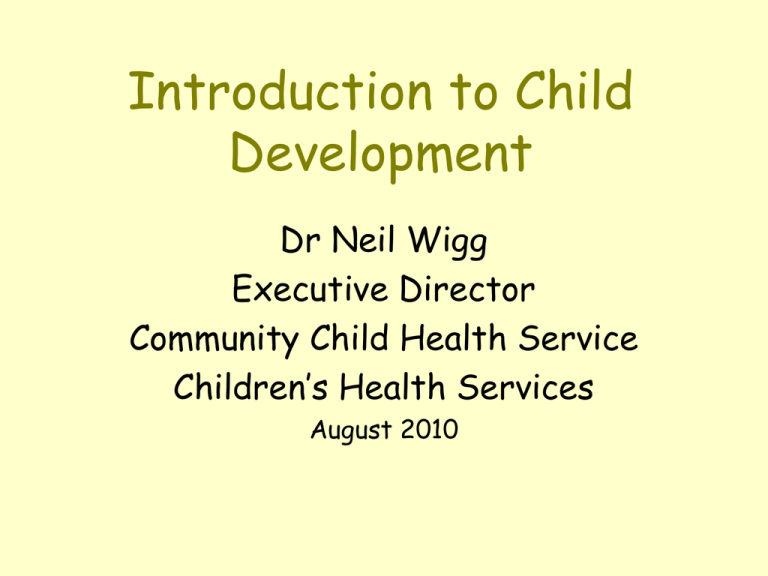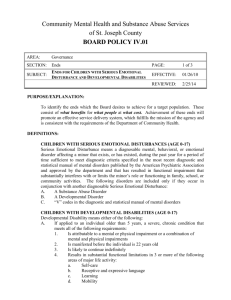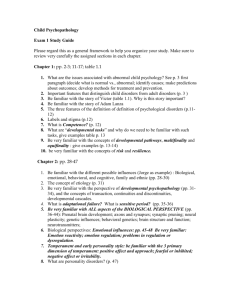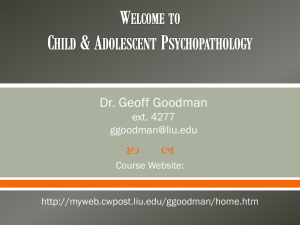Introduction to Child Development - UQMBBS-2013
advertisement

Introduction to Child Development Dr Neil Wigg Executive Director Community Child Health Service Children’s Health Services August 2010 Why child development? • Developmental disorders affect functioning and thus health • Overlap of chronic conditions (especially neurologic) and developmental disorders • Management of medical conditions in childhood is influenced by developmental status • Developmental disorders have a biologic basis and often have life-long implications • Examples of successful medical & other interventions definitions • Defect - abnormality of structure • Deformity - deviation from normal shape or form • Disability - loss/absence of function or skill • Handicap - condition which impedes development, opportunity, expectation or activity Clinical approaches • Based on “objective, observable” elements • Assessment: history observation of behaviour examinations (hearing/vision) formal tests - age referenced • developmental diagnosis Prevalence of Developmental Disorders • Intellectual impairment ~1% (includes impaired adaptive function) • Global Developmental Delay 3% • “Slow Learner” 10-12% • Autism Spectrum Disorder 0.6% • Attention Deficit Hyperactivity Disorder 3-5% • Speech & Language Disorder 5-10% • Permanent Sensorineural Deafness 0.2% Intellectual Impairment • Cognitive functioning on standardised testing of IQ <70 AND Impaired adaptive functioning (related to social adjustment, self-care and practical problem solving) Case example • Jonathon age 7 • Extreme behaviour difficulties in year2 at regular school • Moderate Intellectual impairment • “normal” adaptive/self-care skills Autism Spectrum Disorder • Childhood Autism • Asperger Syndrome • Pervasive Developmental Disorder – not otherwise specified • ?Rett’s Syndrome [Disorders of language, social skills, perception and repetitive/obsessive behaviours] Case example • Jordan age 4 –abilities to read and write • Jordan age 5 – coping with Special Education Development Unit • Jordan age 6 – over-achieving in a Special School environment Case example • Joseph age 6 in year 1 at local State School • Knowledge of electromagnetism • Social rules • Coping with sport ADHD • Criterion based • Use of standard classifications eg DSM4 or ICD10 etc • Inattentive AND impulsive/overactive behaviours • More than one setting • Interferes with functioning Developmental Disorders • Note high level of co-morbidity For example, children with ADHD frequently have developmental co-ordination disorder (DCD), and specific learning disabilities Overlap of ASD with Obsessive Compulsive Disorder and Intellectual Impairment “rule of thumb – 1/3 one disorder, 2/3 more than one disorder” Nature of Development - domains • • • • • motor - gross motor and fine motor communication - speech and language personal-social + emotion cognitive + moral adaptive - problem solving, self regulation Nature of Development - theoretical perspectives • • • • • • Neuro-developmental Psychodynamic Cognitive/structural Social/learning Transactional etc, etc (early) Human Development is • • • • • • Dynamic Sequential Increasingly complex Purposeful Contingent “on-going” Nature of Development - key clinical issues • range of normal • delayed/advanced development • disordered development Concept of developmental health • Early life determinants (Barker hypothesis) • Life course trajectories of health • Neurobiology of brain growth – sensitive periods for development • Impact of early interventions Synthesis of current research “From Neurons to Neighborhoods. The Science of Early Childhood Development” JP Shonkoff & DA Phillips (Editors) Board of Children, Youth and Families US 2000 core concepts 1. Human development is shaped by a dynamic and continuous interaction between biology and experience 2. Culture influences every aspect of human development and is reflected in childrearing beliefs and practices designed to promote healthy adaptation core concepts 3. The growth of self-regulation is a cornerstone of early childhood development that cuts across all domains of behaviour 4. Children are active participants in their own development, reflecting the intrinsic human drive to explore and master one’s environment. core concepts 5. Human relationships, and the effects of relationships on relationships, are the building blocks of healthy development. 6. The broad range of individual differences among young children often makes it difficult to distinguish normal variations and maturational delays from transient disorders and persistent impairments. core concepts 7. The development of children unfolds along individual pathways whose trajectories are characterised by continuities and discontinuities, as well as a series of significant transitions. 8. Human development is shaped by the ongoing interplay among sources of vulnerability and sources of resilience. core concepts 9. The timing of early experiences can matter, but, more often than not, the developing child remains vulnerable to risks and open to protective influences throughout the early years of life into adulthood. core concepts 10 The course of development can be altered in early childhood by effective interventions that change the balance between risk and protection, shifting the odds in favour of more adaptive outcomes. Shonkoff & Phillips 2000 Current directions The Rudd/Gillard Government has • A broad Early Childhood agenda • A focus on developmental health • Introduced the Australian Early Developmental Index (AEDI) nationwide In summary ~ When considering the development of any child think about skills social competence








